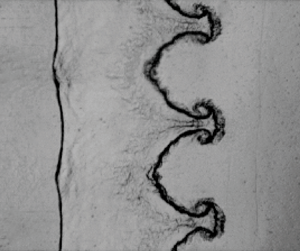Crossref Citations
This article has been cited by the following publications. This list is generated based on data provided by
Crossref.
Guo, Xu
Si, Ting
Zhai, Zhigang
and
Luo, Xisheng
2022.
Large-amplitude effects on interface perturbation growth in Richtmyer–Meshkov flows with reshock.
Physics of Fluids,
Vol. 34,
Issue. 8,
Guo, Wenxuan
and
Zhang, Qiang
2022.
Quantitative theory for spikes and bubbles in the Richtmyer−Meshkov instability at arbitrary density ratios in three dimensions.
Physics of Fluids,
Vol. 34,
Issue. 7,
Wang, He
Cao, Qing
Chen, Chenren
Zhai, Zhigang
and
Luo, Xisheng
2022.
Experimental study on a light–heavy interface evolution induced by two successive shock waves.
Journal of Fluid Mechanics,
Vol. 953,
Issue. ,
Cong, Zhouyang
Guo, Xu
Si, Ting
and
Luo, Xisheng
2022.
Experimental and theoretical studies on heavy fluid layers with reshock.
Physics of Fluids,
Vol. 34,
Issue. 10,
Chen, Chenren
Xing, Yinuo
Wang, He
Zhai, Zhigang
and
Luo, Xisheng
2023.
Freeze-out of perturbation growth of single-mode helium–air interface through reflected shock in Richtmyer–Meshkov flows.
Journal of Fluid Mechanics,
Vol. 956,
Issue. ,
Liang, Yu
Liu, Lili
Luo, Xisheng
and
Wen, Chih-Yung
2023.
Hydrodynamic instabilities of a dual-mode air–SF6 interface induced by a cylindrically convergent shock.
Journal of Fluid Mechanics,
Vol. 963,
Issue. ,
Yang, Tao
Lin, Chuandong
Li, Demei
and
Lai, Huilin
2023.
Influence of Density Ratios on Richtmyer–Meshkov Instability with Non-Equilibrium Effects in the Reshock Process.
Inventions,
Vol. 8,
Issue. 6,
p.
157.
Zhang, Duo
Ding, Juchun
Li, Ming
Zou, Liyong
and
Luo, Xisheng
2023.
Effects of reverberating waves and interface coupling on a divergent Richtmyer–Meshkov instability.
Journal of Fluid Mechanics,
Vol. 975,
Issue. ,
Chen, Yanfeng
Jin, Tai
Liang, Zhenghong
and
Zou, Liyong
2023.
Numerical study of Richtmyer–Meshkov instability of light fluid layer with reshock.
Physics of Fluids,
Vol. 35,
Issue. 11,
Zhang, Yumeng
Zhao, Yong
Ding, Juchun
and
Luo, Xisheng
2023.
Richtmyer–Meshkov instability with a rippled reshock.
Journal of Fluid Mechanics,
Vol. 968,
Issue. ,
Xu, Jinru
Wang, He
Zhai, Zhigang
and
Luo, Xisheng
2023.
Convergent Richtmyer–Meshkov instability on two-dimensional dual-mode interfaces.
Journal of Fluid Mechanics,
Vol. 965,
Issue. ,
Chen, Chenren
Wang, He
Zhai, Zhigang
and
Luo, Xisheng
2023.
Attenuation of perturbation growth of single-mode SF6–air interface through reflected rarefaction waves.
Journal of Fluid Mechanics,
Vol. 969,
Issue. ,
Cong, Zhouyang
Guo, Xu
Zhou, Zhangbo
Cheng, Wan
and
Si, Ting
2024.
Freeze-out of perturbation growth for shocked heavy fluid layers by eliminating reverberating waves.
Journal of Fluid Mechanics,
Vol. 987,
Issue. ,
Li, Jiaxuan
Chen, Chenren
Zhai, Zhigang
and
Luo, Xisheng
2024.
Effects of compressibility on Richtmyer–Meshkov instability of heavy/light interface.
Physics of Fluids,
Vol. 36,
Issue. 5,
Cao, Qing
Chen, Chenren
Wang, He
Zhai, Zhigang
and
Luo, Xisheng
2024.
Interface evolution induced by two successive shocks under diverse reshock conditions.
Journal of Fluid Mechanics,
Vol. 999,
Issue. ,
Zheng, Dugang
Guo, Xu
Zhai, Zhigang
and
Luo, Xisheng
2024.
Simulations on perturbation growth and mixing of a shocked light fluid layer with two different interfaces.
Physics of Fluids,
Vol. 36,
Issue. 12,
Gao, Xing
Guo, Xu
Zhai, Zhigang
and
Luo, Xisheng
2024.
Interfacial instabilities driven by co-directional rarefaction and shock waves.
Journal of Fluid Mechanics,
Vol. 980,
Issue. ,
Li, Linfei
Jin, Tai
Zou, Liyong
Luo, Kun
and
Fan, Jianren
2024.
Numerical study of Richtmyer-Meshkov instability in finite thickness fluid layers with reshock.
Physical Review E,
Vol. 109,
Issue. 5,
Chen, Chenren
Wang, He
Zhai, Zhigang
and
Luo, Xisheng
2024.
Mode coupling between two different interfaces of a gas layer subject to a shock.
Journal of Fluid Mechanics,
Vol. 984,
Issue. ,
Panchal, Achyut
and
Menon, Suresh
2024.
A Comparison of Re-shock Mixing due to Richtmyer-Meshkov Instability in a Laboratory Channel and Free-Field Domain.




